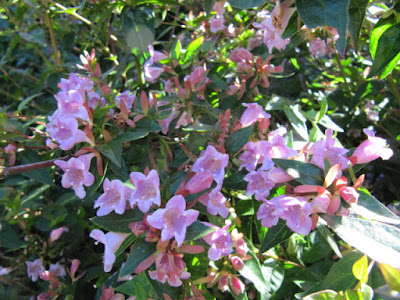Abelia Edward Goucher, a little more compact than Abelia grandiflora, remarkably floriferous, is also a hybrid variety more resistant to cold. This delicate shrub, with arched branches, has a small evergreen foliage which takes on a beautiful bronze-coppery to purplish hue under the effect of the cold, and offers a long and abundant flowering...
Abelia Edward Goucher, a little more compact than Abelia grandiflora, remarkably floriferous, is also a hybrid variety more resistant to cold. This delicate shrub, with arched branches, has a small evergreen foliage which takes on a beautiful bronze-coppery to purplish hue under the effect of the cold, and offers a long and abundant flowering.
Its small flowers in pink bells give way to pretty red bracts that persist for a long time on the plant. Easy to grow and undemanding, attractive a good part of the year, it will bring lightness and softness to the garden. Perfect in a small hedge, it will be well developed in the center of a group of perennials or persistent shrubs.
Abelia Edward Goucher details:
The Abelia x grandiflora Edward Goucher is an excellent horticultural variety dating back to 1911. This compact shrub of the family Caprifoliaceae is derived from Abelia x grandiflora, a vigorous, undemanding and hardy species, and Abelia schumannii, with less important development . Of fairly rapid growth, Edward Goucher will reach about 1.75 m in all directions. Its port is globally rounded and bushy from the base.
This Abelia offers a long, slightly fragrant bloom which usually begins at the end of August and continues until the first cold, when few shrubs are still in bloom. Its innumerable small funnel-shaped corollas, 2 cm wide, with pearly white throat and pink lilac lapels, are gathered in panicles at the axils of the leaves on the twigs of the year.
The flowers, fading, give way to pretty chalices composed of rust-colored bracts, very decorative on the fall foliage. The slender, arched branches of the Abelia bear small, glossy, semi-evergreen to evergreen leaves, depending on the severity of winter, light green in color until summer. Under the effect of the first cool nights, the foliage becomes more or less tanned, purplish or reddish and persists for a long time on the branch.
This Abelia is also very resistant to summer drought once established, which can accommodate it in many areas. It can be found in groups with other shrubs as well as isolated or in a medium hedge. You can also plant it in the center of a group of perennials or shrubs such as the Baptisia, shrubby sage, daylily, as well as free or cut hedge.
Grow and care Abelia Edward Goucher:
The Abelia Edward Goucher enjoys a sunny or partial shade, wherever winter temperatures do not drop below -15 / -17 ° C. This hardiness, however, concerns a well-established shrub placed in sheltered exposure to cold, dry winds in healthy, drained soil. This plant is resistant to summer drought, spray and wind but protect it when young frost.
This plant is plant in spring or early fall in a light soil, rather fertile, and well drained. The ideal is planting in a balanced mix of potting soil and garden soil. Easily cultivated, the Abelia requires little maintenance and tolerates the presence of limestone in the soil.
Between February and April, before resuming, prune the sick or dead wood and keep only the vigorous branches to maintain the compact habit of the shrub. Flowering takes place on the shoots of the year. Avoid pruning in the fall to avoid compromising the cold resistance of your Abelia. At the end of winter, trim the points damaged by the cold and even the silhouette to maintain a harmonious port.

















COMMENTS